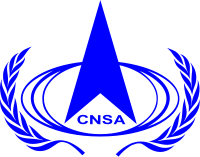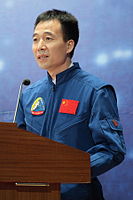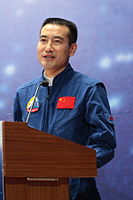- China National Space Administration
-
"CNSA" redirects here. For other uses, see CNSA (disambiguation).This article is about the current Chinese space agency. For the Chinese space program in general, see Chinese space program.
China National Space Administration
国家航天局
CNSA logoOwner  China
ChinaEstablished 22 April 1993 Headquarters Beijing, China Primary spaceport Jiuquan Satellite Launch Center Administrator Chen Qiufa Budget US$500 million (official); US$1.3 billion (Euroconsult)[1] Website www.cnsa.gov.cn China National Space Administration Traditional Chinese 國家航天局 Simplified Chinese 国家航天局 Cantonese Jyutping Gwok3 Gaa1 Hong4 Tin1 Guk6 Cantonese Yale Gwo Jya Hang Tyan Jyu Hanyu Pinyin Guó Jiā Háng Tiān Jú Transcriptions Mandarin - Hanyu Pinyin Guó Jiā Háng Tiān Jú - Wade–Giles Kuo Chia Hang T'ien Chü - IPA [kwɔ̌ tɕjá xɑ̌ŋ tʰjɛ́ntɕy̌] Cantonese (Yue) - Jyutping Gwok3 Gaa1 Hong4 Tin1 Guk6 - IPA [kʷɔ̄ːk.gáː.hɔ̭ːŋ.tīn.kùːk] - Yale Romanization Gwo Jya Hang Tyan Jyu The China National Space Administration (CNSA, Chinese: 国家航天局; pinyin: Guó Jiā Háng Tiān Jú, literally "National Astronautics Department") is the national space agency of the People's Republic of China responsible for the national space program.[2] It is responsible for planning and development of space activities. CNSA and China Aerospace Corporation (CASC) assumed the authority over space development efforts previously held by the Ministry of Aerospace Industry.
Contents
History
Although China's space program has existed since 1956, CNSA is a relatively new agency created in 1993 when the Ministry of Aerospace Industry was split into CNSA and the China Aerospace Corporation (CASC). The former was to be responsible for policy, while the latter was to be responsible for execution. This arrangement proved somewhat unsatisfactory, as these two agencies were, in effect, one large agency, sharing both personnel and management.[2]
As part of a massive restructuring, in 1998, CASC was split into a number of smaller state-owned companies. The intention appeared to have been to create a system similar to that characteristic of Western defense procurement in which entities which are government agencies, setting operational policy, would then contract out their operational requirements to entities which were government-owned, but not government-managed.[2]
Function
CNSA was established as a government institution to develop and fulfill China's due international obligations, with the approval by the Eighth National People's Congress of China (NPC). The Ninth NPC assigned CNSA as an internal structure of the Commission of Science, Technology and Industry for National Defense (COSTIND). CNSA assumes the following main responsibilities: signing governmental agreements in the space area on behalf of organizations, inter-governmental scientific and technical exchanges; and also being in charge of the enforcement of national space policies and managing the national space science, technology and industry.
Up to now, China has signed governmental space cooperation agreements with Brazil, Chile, France, Germany, India, Italy, Pakistan, Russia, Ukraine, the United Kingdom, the United States and some other countries. Significant achievements have been scored in the bilateral and multilateral and technology exchanges and cooperation.[2]
Administrators of CNSA are appointed by the State Council.
Future missions
FY 2011
- Tiangong 1 : 9.4 ton "space laboratory module" launched in 2011.
- Yinghuo 1 : un-manned Mars probe scheduled for launch in 2011. The Russian sample return mission Phobos-Grunt will be sent together with Yinghuo 1.
FY 2013
Space travelers
As of 2011, six Chinese nationals have traveled in space (alphabetical order) :
Administration
The current administrator is Chen Qiufa, appointed in 2010. Jin Zhuanglong and Luo Ge were appointed as vice-administrators in 2005.
List of Administrators
- April 1993: Liu Jiyuan
- April 1998: Luan Enjie
- 2004: Sun Laiyan
- 2010: Chen Qiufa
Departments
There are four departments under the CNSA:
- Department of General Planning
- Department of System Engineering
- Department of Science, Technology and Quality Control
- Department of Foreign Affairs
CNSA logo
CNSA's logo is a similar design to that of China Aerospace Science and Technology Corporation.[3] The arrow in middle has a similar shape as the Chinese character 人 which means 'human' or 'people', to state that human is the center of all space explorations. The three concentric ellipses stand for three Escape Velocity (minimum speed needed to move around earth, to escape earth system and to escape the solar system) which are milestones of space explorations. The second ring is drawn with a bold line, to state that China has passed the first stage of exploration (earth system) and is undergoing second stage exploration (within the solar system). The 人 character stands above the three rings to emphasize on humanity's capability to escape and explore. Olive branches were added to state that China's space exploration is peaceful.
See also
References
External links
China National Space Administration (CNSA) Robotic programs PastCurrentIn developmentHuman spaceflight
programsCurrentIn developmentPast missions Spaceports People ScientistsDu Qinghua · Fan Ruixiang · Hu Haichang · Huang Chunping · Long Lehao · Luan Enjie · Ouyang Ziyuan · Qi Faren · Qian Xuesen · Sun Laiyan · Wan Hu · Wang Yongzhi · Wei Yiqing · Ye Peijian · Zhuang Fenggan · Zhang Guitian · Zhao Jiuzhang · Zhu MiaolongAstronautsChinese space facilities and organizations Centers Space citiesDongfeng space city · Beijing space city · Wenchang space city · Shanghai space city · Yantai space city · Guizhou Aerospace Industrial ParkMonitoring and
control centersBeijing Aerospace Command and Control Center · Xi'An Satellite Monitor and Control Center · China Deep Space Tracking Network · Yuanwang-class space tracking ships · China Domestic Tracking Stations · China Overseas Tracking StationsLaunch sites Suborbital launch sitesOrbital launch sitesManned spacecraft
landing siteAssociated
organizationsUniversities and institutesCAS Key Laboratory of high-temperature gas dynamics · China Aerodynamics Research & Development Center · Beijing University of Aeronautics and Astronautics · School of Aeronautics, Harbin Institute of Technology · School of Aeronautics and Astronautics, Zhejiang University · China's Space Medical InstituteMinistries and agenciesChina Ministry of Aerospace Industry · China National Space Administration · China Aerospace Science and Technology Corporation · China Academy of Launch Vehicle Technology · Fifth Academy of the Defence Ministry · China Aerospace CorporationPublic sector space agencies Africa North AfricaSub-SaharanAmericas North AmericaSouth AmericaAsia East AsiaSoutheast AsiaSouth AsiaSouthwest AsiaCentral AsiaEurope Oceania World Categories:- Space agencies
- Chinese space program
- 1993 establishments in China
Wikimedia Foundation. 2010.






